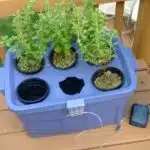Lima beans are a nutritious and tasty legume that can be easily grown in gardens around the world. For gardeners looking to cultivate this hearty crop, it’s important to understand the basics of lima bean growth and the best methods to ensure successful results. With proper research, planting, and maintenance, you can enjoy a bountiful harvest of these delightful legumes.
Growing lima beans is an easy and rewarding gardening experience. Whether you’re just getting started in your first backyard plot or are an experienced gardener looking for new challenges, lima beans are a great choice for your garden. With careful planning and dedication, you can reap the benefits of a successful lima bean harvest with minimal effort.
For those interested in learning more about growing these delicious vegetables, this article will cover all aspects of successful lima bean cultivation from planting through harvesting. By following these tips and tricks from an experienced botanist and gardener, you’ll have everything you need to achieve maximum yields from this hardy crop.
Choosing The Right Lima Bean Variety
It’s often said that you can’t grow something from nothing. However, if you choose the right lima bean variety and adequately prepare the soil, you can reap a successful harvest of these nutritious legumes. Here are some tips for how to get started.
With so many different varieties of lima beans, it can be difficult to know which one is best suited for your climate and soil type. Generally speaking, pole beans produce more yield than bush beans, but they require additional support in order to climb. If your garden has limited space or poor soil quality, bush beans may be a better option. Consider factors like days to maturity and disease resistance when making your decision.
Once you have chosen the right variety for your garden, it is time to prepare the soil with compost or fertilizer. The ideal pH range for growing lima beans is 6-7; test the pH level before planting and adjust accordingly by adding either lime or sulfur depending on what is needed. Additionally, loosen up the topsoil by tilling or digging down 10-12 inches in order to create a well-draining medium that will give your plants plenty of room to thrive.
With these considerations in mind, you should have everything you need to start growing healthy lima beans this season!
Preparing The Soil
The next step in the process of growing lima beans is preparing the soil. While different varieties have their own preferences in terms of soil type, consistent moisture and good drainage are essential for all. Preparing the soil prior to planting is an important part of ensuring that the lima plants grow healthy and thrive.
The first step in preparing the soil for lima bean growth is to ensure that it contains a lot of organic material. This helps promote healthy root growth and also provides nutrients for the plant over time as it decomposes. Compost is one of the best choices for this, but it’s also possible to use well-rotted manure or other organic materials. It’s important to make sure these materials are thoroughly incorporated into the soil before planting.
Once you’ve ensured your soil has adequate organic content, you’ll want to test its acidity levels with a pH meter or test kit. Most varieties prefer a slightly acidic environment, so if your soil has a neutral or alkaline pH level, adding sulfur can help lower it to an acceptable range. When all these steps are completed, your soil should be ready for planting.
Planting Lima Beans
Planting lima beans is an essential part of the growth process. It’s important for gardeners to know the proper techniques so that their harvests are successful. To begin, you’ll need to choose a spot in your garden where you can receive full sunlight, as lima beans need at least six hours of direct sunlight each day. Make sure the soil is loose and well-drained, and that it has been amended with compost or manure before planting.
Once you’ve selected the location, use your finger to make small holes about two inches deep into the soil. Drop several seeds into each hole, spacing them out evenly. Cover up the holes with some soil and press down gently. If you want to save space and energy, try planting your lima beans in rows rather than scattering them randomly throughout your garden bed.
Water your lima bean plants regularly and make sure they’re receiving enough nutrients from the soil so they can thrive. Mulching around the base of the plant can help retain moisture and prevent weed growth. With these simple steps, you can ensure healthy lima bean plants that will produce an abundance of pods ready for harvest when they reach maturity!
Watering & Caring For Plants
As the saying goes, ‘you reap what you sow’ – and this is especially true for Lima beans. Caring for them correctly will ensure healthy, productive plants that will reward your efforts with delicious beans. When it comes to watering and caring for Lima bean plants, here’s what you need to know:
Firstly, Lima beans should be watered regularly but not excessively. Aim to water every few days or so, only enough to keep the soil moist but not soggy. If your area is particularly dry due to lack of rainfall or high temperatures, then you may need to water more often. Secondly, mulch can help retain moisture in the soil and prevent weed growth. Finally, stake or cage your Lima bean plants if they start getting too tall or unruly; this will help support their stems and keep the pods off the ground where they are more vulnerable to pests and disease.
In addition to these three tips for watering and caring for Lima bean plants, it’s also important to control weeds when growing them. Weeds can compete with the plant for resources like sunlight, water, and nutrients – leading to poor growth in your Lima beans and a less than satisfactory harvest. Fortunately, controlling weeds is much easier when done early on in the season before they get out of hand!
Controlling Weeds
Weeding out the unwanted plants is a critical step in cultivating successful lima bean crops. It can be a tedious chore, but it’s necessary to ensure the health and growth of your plantings. Like the old saying goes, “A stitch in time saves nine”. As an experienced botanist and gardener, I’ll share with you a few key tips and strategies for controlling weeds in your garden.
For starters, let’s talk about pre-emergent weed control. This involves using an herbicide before any weeds appear above ground to prevent them from germinating. It’s important to select a product that suits your particular needs: • For small gardens – Use a post-emergent herbicide that won’t harm beneficial insects or other wildlife • For large gardens – Use a pre-emergent herbicide to keep weeds from germinating at all
Next up is manual weed control. This involves pulling out any existing weeds by hand or digging them out with tools such as hoes or trowels. It may take more time and effort than using chemical products, but it is also much friendlier to the environment and more cost effective in the long run. Here are some helpful tips: • Pull weeds when they are young before their roots have had a chance to spread • Wear gloves and protective clothing when weeding • Remove any seed heads or seedlings you come across • Mulch around plants to discourage weed growth These techniques will help you stay ahead of any pesky weeds that might compete with your lima bean plants for space, light and water.
By taking proactive steps such as these, you’ll be well on your way towards harvesting healthy lima beans!
Harvesting Lima Beans
Once the lima beans have grown to maturity, it is time to harvest them. This is an exciting stage of the growing process, as after all your hard work you can finally enjoy the fruits of your labor! Harvesting should be done when the pods are plump and full, with a bright green color. To harvest, simply pick off each pod from the plant and store them in a cool place until you are ready to use them. It is important to leave some of the pods on the plant as they will continue to grow and ripen even after harvesting. To ensure maximum yield, make sure to check your plants regularly for any signs of disease or pests that could prevent your lima beans from maturing properly. Once harvested, you can then enjoy their delicious flavor in soups and stews or other dishes. With proper care and attention, you can easily grow a bumper crop of lima beans every season! With these tips in mind, let us move onto companion planting for optimum growth results.
Companion Planting
Companion planting is an important technique in gardening and botany that can be beneficial for lima beans. It involves the strategic placement of different plants near one another to create a mutually beneficial garden environment. Planting companion plants near lima beans can help reduce pests and diseases, provide nutrients, attract pollinators, and improve soil fertility.
The most common companion plant for lima beans is corn. Corn provides a physical barrier for the lima bean plants, which helps keep predators away from the tender plants. Additionally, planting corn nearby will also attract pollinators like bees, who will then benefit the lima bean plants with increased pollination.
Finally, legumes like clover can be planted alongside lima beans to add nitrogen to the soil. Legumes are able to absorb nitrogen from the air and store it in their roots which can then be released into the soil as they decompose – providing essential nutrients for your lima bean plants! Taking advantage of this natural process through companion planting is an effective way to ensure that your lima bean plants have access to all of the necessary nutrients they need to flourish in your garden.
No matter what combination of companion plants you choose, utilizing companion planting techniques when growing your lima beans will give them a greater chance at success – helping you reap a bountiful harvest come harvest time! And with proper fertilization practices, you’ll be sure to get even more out of this fantastic crop!
Fertilizing Lima Beans
Fertilizing lima beans is an important step in the process of successfully growing them. Picture a field of lush plants, each one strong and healthy, as if they are nourished by the sun’s rays and the cool breeze. For gardeners looking to achieve this type of success, providing their lima bean plants with adequate fertilizer is essential.
When it comes to fertilizing lima beans, a balanced fertilizer should be used that has been specifically formulated for legumes. This will ensure that the nitrogen levels are correct for optimal growth and production. Additionally, it is important to make sure that the soil pH is between 6 and 7 before any fertilizer is applied. If the soil pH is too low, then additional lime may need to be added before any fertilizer can be applied.
Gardeners should also consider adding compost or manure to their soil in order to provide additional nutrients for their lima bean plants. Compost helps increase organic matter in the soil which can help improve drainage and aeration while also providing essential nutrients for plant growth. Manure also provides similar benefits plus additional micronutrients which can help promote healthy root development and vigorous foliage growth on your lima bean plants.
By taking these steps and applying proper fertilization techniques, gardeners can create an environment that supports healthy lima bean growth and production throughout the season. With ample nutrients available in the soil, gardeners can look forward to harvesting a plentiful crop of delicious lima beans later in the year!
Limiting Insect Damage
Limiting insect damage is a necessary part of growing lima beans. Insects can wreak havoc on the plants, reducing yields and making them unappealing to eat. But with a few simple steps, gardeners can protect their lima beans from these pesky pests.
Figuratively speaking, these insects are like hungry predators waiting for the perfect opportunity to feast on your hard-earned crop; so let’s take a look at how to safeguard your lima beans from these intruders:
First, regularly check your plants for any signs of insect activity. This includes looking for chewed leaves or eggs laid by the insects. Second, prune off any affected leaves or stems as soon as you spot them to keep the damage in check. Third, use organic pest control solutions such as neem oil or insecticidal soap when possible. Fourth, use floating row covers over your plants during vulnerable times of the season to keep out bigger bugs. And finally, if all else fails, use an appropriate chemical pesticide that is safe for food crops as a last resort.
As a specialist in botany and gardening, I know that taking these steps can help ensure your lima bean plants stay healthy and productive throughout the season. By following this guide and staying vigilant against insect damage, you’ll be able to enjoy delicious homegrown lima beans in no time! Moving forward we will explore common diseases and pests that could affect your harvest…
Common Diseases & Pests
It is important to be aware of the potential diseases and pests that can affect your lima bean plants. As a gardener, it is your responsibility to take measures to protect your plants from these issues. In this section, we will discuss some common diseases and pests to look out for as you grow lima beans.
Fungal diseases are one of the most common problems with lima beans. Common fungal diseases include anthracnose, rust and damping off, all of which can cause serious damage if left untreated. To reduce the risk of fungal disease, ensure that your soil remains well-drained and avoid overwatering the plants. If any signs of disease are present on your plants, remove them promptly and treat the soil with an appropriate fungicide.
Insects such as aphids and leafhoppers can also pose a threat to lima beans. You should regularly inspect your plants for signs of insects such as webbing or holes in the leaves. Beneficial insects like ladybugs and lacewings can help control pest populations without damaging your crops; however, if you have a large infestation, chemical pesticides may be necessary.
By taking preventive measures against potential diseases and pests, you can increase the chances of successful growth for your lima bean plants. With proper care and attention, you can ensure that they reach their full potential in terms of size and yield. As we move onto the next step in this process – saving & storing lima beans – remember to keep these tips in mind!
Saving & Storing Lima Beans
Once your lima beans are fully mature, saving and storing them correctly is key to preserving their flavor and prolonging their shelf life. The process is surprisingly simple. First, harvest the beans when they’re visibly plump but still firm to the touch. Then, carefully remove the pods from the plants, being sure not to damage them in any way. Next, place them in a single layer on a tray or plate and allow them to dry for several days until all the moisture has evaporated.
Finally, store your dried lima beans in an airtight container in a cool, dark place such as a pantry or cupboard. To ensure maximum freshness and longevity of your stash of lima beans, make sure that you check the container every few weeks for signs of spoilage or mold growth and discard any affected beans immediately. By following these steps and taking proper care of your lima beans, you can keep them fresh for up to six months.
Now that you know how to save and store your lima beans properly, let’s move on to planting and growing in containers!
Planting & Growing In Containers
“You can’t have a garden without planting”, goes the old adage. Planting and growing lima beans in containers is a great way to enjoy the harvest from your own backyard and get the most out of your crop. Here are some tips for successful container gardening:
- Choose a pot that is at least 12 inches deep and wide, with drainage holes at the bottom.
- Use soil that is rich in organic matter, such as compost or aged manure.
- Fertilize regularly with an all-purpose fertilizer, following the directions on the package.
- Water your plants regularly – it’s best to water them deeply once a week rather than lightly every day.
As a specialist in botany and gardening, I recommend container gardening for lima beans because it allows you to control their environment better than if they were planted directly into the ground. Container gardening also gives you greater flexibility when it comes to location – you can move them around easily to find the spot with just the right amount of sun or shade for optimum growth and yield! Plus, if you’re looking for a low-maintenance option, then container gardening could be just what you need – no weeding required!
To ensure optimal plant health, provide plenty of nutrients and water to keep your lima beans thriving throughout their growing season. Regularly feed your plants with compost tea or liquid fertilizer throughout the season, mulch around plants to retain moisture, rotate crops each year, and remove any diseased foliage immediately before mildew can spread to other parts of your garden. Follow these tips and you’ll be sure to have a plentiful harvest come fall!
Tips For Optimal Plant Health
Giving your lima beans the best care possible is like giving them a warm hug. With just a few simple tips, you can ensure that your lima bean plants are growing to their fullest potential. As an expert in botany and gardening, let me guide you through making sure that your lima beans stay healthy and happy.
To start, it’s important to give your plants the right amount of water. Too much water can drown the roots, while too little will dry them out and stunt their growth. You’ll want to give your plants about 1-2 inches of water per week, depending on temperatures and rainfall amounts. Make sure to check the soil before each watering; if it’s damp, wait until it dries out more before watering again.
Fertilizer is also key for optimal plant health. A balanced fertilizer with nitrogen, phosphorus and potassium will do the trick for most soil types. Apply it every 3-4 weeks throughout the growing season for best results. Finally, make sure to keep weeds away from your plants since they can compete for nutrients in the soil and cause unhealthy growth patterns in your lima beans.
By following these simple steps, you’ll be able to provide your lima bean plants with everything they need to thrive – now you just have to harvest those delicious beans!
Preparing Lima Beans For Eating
Once the lima beans have grown to maturity, they must be harvested and prepared for eating. Harvesting should typically take place when the pods are full, but before they start to turn yellow. When harvesting, it is important to remove any diseased or damaged pods. The remaining pods can then be prepared for eating.
To prepare lima beans for eating, they first need to be shelled. This can be done by simply snapping off the stem end of the pod and pulling back the fibers along the seam of the two sides of each pod until all of the seeds are removed. After shelling, it is recommended that you rinse them in water and remove any discolored or damaged seeds.
The next step is to cook them. Lima beans can be boiled, steamed, sautéed or added to soups or stews. Boiling is probably the most common method as it produces tender beans with a creamy texture without losing any of their nutritional value. Whatever method you choose, make sure that you cook them until they are tender before serving them up as part of a delicious meal!
Having discussed how to prepare lima beans for eating, we can now move on to exploring other uses for this versatile legume.
Other Uses For Lima Beans
Like a loyal friend, lima beans can be relied upon for more than just nutrition. They are versatile, resilient, and can provide many benefits in the garden. As an experienced botanist and gardener, let me take you through these other uses of lima beans.
Firstly, they can help to improve the soil quality. Lima beans produce nitrogen-rich cover crop which can be used to aerate soils and build up organic matter content. This makes them ideal for adding extra nutrients and moisture to gardens or vegetable patches that have been neglected or degraded over time. Furthermore, their deep roots help loosen compacted soil so other plants are able to grow as well.
Secondly, lima beans also act as a great pest deterrent. Planting them around the perimeter of your garden will help ward off unwanted insects such as aphids and moths without needing harsh chemicals or traps. Additionally, they act as a natural fence which discourages wildlife from entering your yard or stealing crops from your vegetable patch.
Finally, the leaves of lima bean plants are edible too! The young leaves can be harvested and added to salads or cooked dishes – they have a mild cabbage-like taste with some nutty notes as well! Or if you’re feeling creative, why not try making lima bean pesto? Just blend some cooked lima beans with garlic, olive oil and Parmesan cheese – it’s delicious!
Overall, there’s more to the humble lima bean than meets the eye – it provides us with nutrition but also acts as an all-round garden helper too! So why not give growing some a go this season?
Frequently Asked Questions
What Is The Ideal Soil Ph For Growing Lima Beans?
When growing lima beans, it is important to make sure that the soil has the ideal pH for optimal growth. The ideal soil pH for lima beans is between 6.0 to 7.0, which is slightly acidic. This means that you should test your soil’s pH and adjust accordingly so that it falls within this range. It is generally easier to lower the pH of soil through the addition of sulfur or aluminum sulfate, while adding lime can raise the pH if needed.
Once your soil has been tested and adjusted as necessary, you will need to prepare a planting bed for your lima beans by tilling and amending with compost or manure, if desired. This will help ensure good drainage and improve fertility in the soil. Once planted, lima beans need regular watering and plenty of sunlight in order to thrive. Make sure they get at least six hours of direct sun each day during the growing season and keep them well-watered throughout their lifecycle – too little water can cause stunted growth or reduce yields significantly.
The key to healthy lima bean plants lies in providing them with optimum conditions for their growth; this includes providing an ideal soil pH balance as well as proper water and sunlight levels so that they have everything they need to flourish. When done correctly, you’ll be rewarded with a plentiful harvest of delicious lima beans!
How Often Should Lima Beans Be Fertilized?
As any specialist in botany and gardening knows, correctly fertilizing lima beans is essential for a successful crop. The frequency of fertilization, however, depends on the soil type and environment. To ensure that your lima beans are getting the nutrition they need to grow abundantly, it is important to understand how often you should be providing fertilizer.
Surprisingly, a coincidence may help us answer this question: Lima beans require the same amount of nitrogen as peas and most other legumes. As such, you can use the recommended fertilization schedule for peas to determine how often you should be fertilizing your lima beans.
The ideal fertilizer schedule for peas is approximately every six weeks during the growing season. If you live in a particularly warm area with higher temperatures and more frequent rainfalls, you may need to increase the frequency of your fertilizer application to once every three or four weeks. On the other hand, if you live in an area with cooler temperatures and less rainfall, then fertilizing once every eight weeks could be sufficient.
Whatever your location and climate conditions may be, it’s best to check your soil regularly throughout the growing season so that you can make adjustments as needed. A soil sample test will provide helpful information about your soil’s exact nutrient content so that you can decide whether or not additional fertilizer is necessary for your lima bean plants.
What Is The Best Way To Prevent Insect Damage?
When it comes to protecting your lima beans from insect damage, prevention is the best approach. It’s important to understand the types of pests that may target your plants and take steps to minimize the potential for damage. Keep in mind that these methods are not foolproof, but they can help reduce the chances of major infestations.
One way to ensure that your lima beans stay healthy is by maintaining good cultural practices. This includes making sure that you rotate crops every year, since different insects tend to be attracted to certain plants. Additionally, remove any weeds near your garden bed as this can provide shelter for pests and make them more likely to attack your lima beans. Also, avoid overwatering as this can encourage disease-causing fungi and other organisms which may attract unwanted insects.
It’s also a good idea to use natural insect repellents such as essential oils or neem oil sprays. These sprays will provide a barrier around your plants which will discourage many common garden pests from entering. You should also make sure that there are no areas around your garden where standing water accumulates, as this can attract mosquitoes and other flying insects that may carry diseases or lay eggs on your plants. By taking these preventive measures, you can significantly reduce the chances of infestation and keep your lima beans safe and healthy throughout the growing season.
By following these simple steps, you’ll be able to protect your lima beans from insect damage and enjoy a successful harvest!
Is There A Way To Extend The Shelf Life Of Lima Beans?
Growing lima beans is an easy and rewarding task. But, do you know how to extend the shelf life of these delicious legumes? As a specialist in botany and gardening, let me tell you about some simple ways to keep your lima beans fresh for longer:
Parallelism creates imagery – imagine extending their shelf life with the following tips: • Store them in a cool and dry place; • Keep them away from sunlight; • Seal them in airtight containers; • Only harvest what you intend to use immediately.
These steps will help prevent oxidation and moisture loss, which are two factors that contribute to reducing lima bean shelf life. Additionally, storing them in an appropriate environment can also help preserve their flavor. It’s important to note that freezing or refrigerating lima beans may cause them to become soft or mushy over time. Therefore, it’s best to keep them at room temperature for optimal shelf life.
There are several other methods for extending the shelf life of lima beans such as blanching them before freezing or canning them for extended storage periods. When dealing with preservation of any type of food item, make sure to follow all instructions carefully for best results!
Are There Any Other Vegetables That Can Be Planted Alongside Lima Beans?
Gardening and planting can be a rewarding experience, especially when discovering the various ways to mix and match different vegetables. Lima beans are an excellent choice for any garden because of their widespread availability and versatility. But what else can be planted alongside this elegant vegetable?
The answer is yes! While lima beans require moisture and plenty of sun for optimal growth, there are several other vegetables that thrive in similar conditions. For example, cucumbers, squash, and peppers are all suitable companions for growing lima beans. Planting these vegetables together can create a vibrant, productive garden that will produce healthy harvests throughout the season.
When planting vegetables together in a garden bed, it is important to pay attention to the spacing between each crop. This will ensure that all plants receive enough sunlight and nutrients to reach their full potential. Additionally, keeping weeds away from your crops is essential for preventing them from competing with your vegetables for resources. With proper care and attention, you can enjoy a colorful array of vegetables in your garden beds!
Conclusion
Growing lima beans is an enjoyable activity for any gardening enthusiast. With the right soil pH, adequate fertilization, and pest prevention methods, you can successfully cultivate your own crop of these delicious legumes. It’s important to remember that lima beans are a relatively short-lived vegetable, so harvesting and preserving them quickly is essential to ensure their quality and extend their shelf life.
By planting other vegetables alongside your lima beans, you can create a delightful garden oasis with a variety of colors and flavors. The possibilities are endless! Whether you’re looking to add some color or just wanting to mix up your current crop rotation, there’s something special about watching your garden grow and thrive with the added bonus of being able to enjoy the fruits of your labor.
Gardening with lima beans is an adventure and the rewards are plentiful. The process may seem daunting at first, but by following simple guidelines and putting in some time and effort, you’ll be able to reap the benefits of growing these nutritious legumes in no time—and be sure to savor every bite!





























